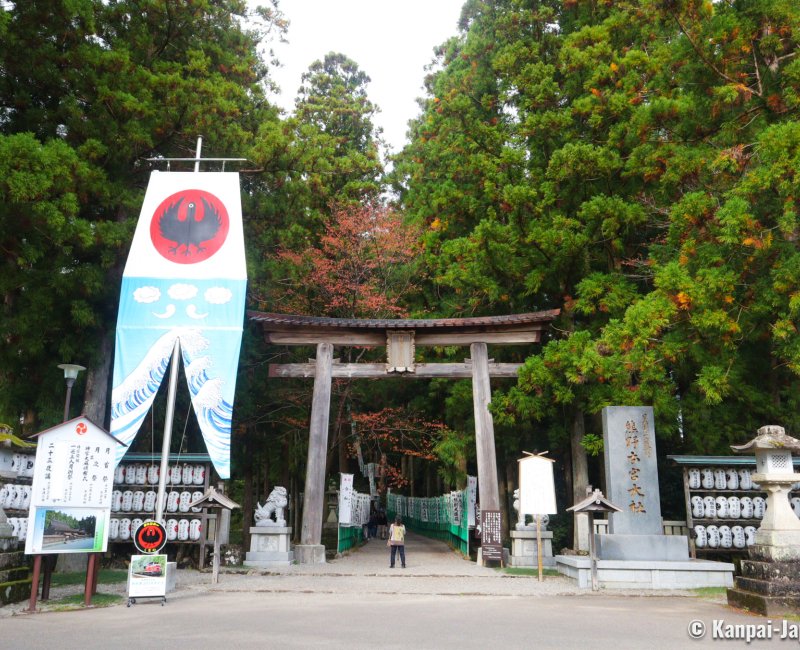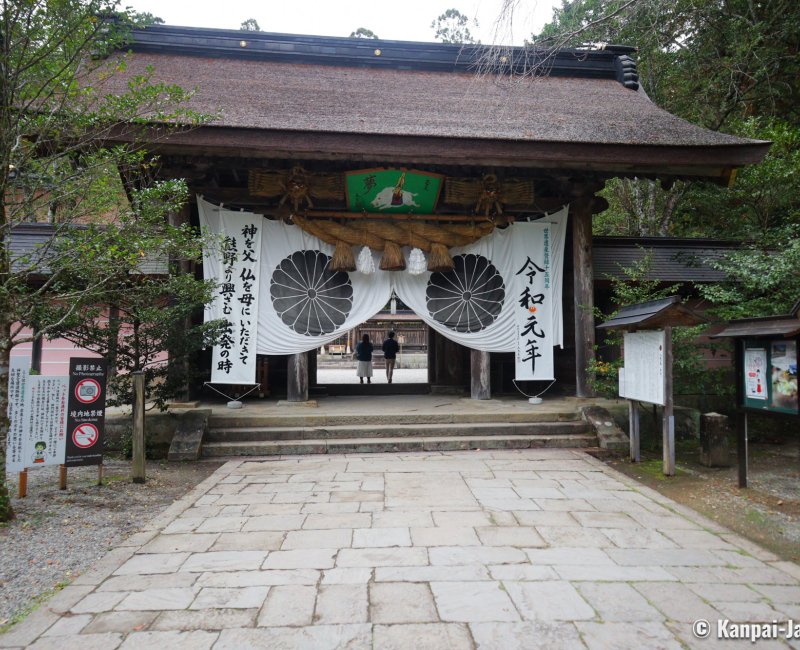Kumano Hongu Taisha
The Shrine in the Heart of the Kumano Pilgrimage
Kumano Hongu Taisha is an important Japanese Shinto shrine and one of the three sacred sites of Kumano Sanzan, affiliated to Tanabe city in Wakayama prefecture. Due to its specific location in the heart of the Kumano Kodo, all the pilgrimage trails radiate around this large monument inscribed to the UNESCO World Heritage List.
Kumano Hongu Taisha is more than 800 years old, but its was transferred to its current location in 1891. The shrine was initially build one kilometer further south, in Oyunohara at the confluence of three rivers. In 1889, a large-scale flood destroyed almost all the buildings and forced the head-priest to find a safer location, sheltered from bad weather conditions.

A shrine completely blended in nature
Nowadays, the entrance of the temple is of an easy access, on the side of a road with a dedicated bus stop. Then, a walk into the forest leads to the sacred grounds. After the large torii ⛩️ gate and the two komainu guardian statues, an impressive 158-steps stone stairway unfolds sided with huge Japanese cypress and banners. This long introduction allows visitors and pilgrims to travel to another world, in an appropriate quiet ambiance.
After purifying by washing both hands and mouth at the temizuya (or chozuya) ablution basin, visitors enter in the holy heart of the site by the Shinmon Gate, topped by a majestic shimenawa braided rope. Its impressive size reminds of the place’s importance in the Shinto cult. It is by the way the first of the 3,000 Kumano shrines throughout the archipelago. The most important kami deities of the Shinto pantheon are worshiped here:
- Amaterasu Omikami, Sun goddess and mythical ancestor of the Imperial family;
- Susano no Mikoto, Amaterasu’s brother, god of the sea and the wind; as well as,
- The deities of the two other great shrines of Kumano Sanzan (Hayatama and Nachi), some of which also belong to the Buddhist pantheon.
The four main buildings constitute the Honden, the "house of the gods", and are of a remarkable sobriety and beauty. The architecture, in appearance simple, perfectly blends in the surrounding nature and uses "natural" jointing techniques, that is to say very few nails or screws. Some visitors will enjoy the refined aesthetic and the spirituality of the site, while others could be disappointed due to a certain "lack" of grandiloquence. For a more spectacular view, we recommend going to Kumano Nachi Taisha that displays a vermilion pagoda and a large waterfall.
The various pavilions are well-maintained and benefit from regular renovation works. The traditional roofing made with hinoki (cypress) bark, in particular, are replaced on average every fifty years. The last renovation of these thatched roofs lasted three years, from 2010 to 2012.

A lively place of worship for all the Japanese people
Kumano Hongu Great Shrine is an ancient and important place of religious syncretism in Japan. People come with family, as couples or with friends to solicit the help and benevolence of its powerful gods. For this, there is a formal way to pray:
- Deposit money (a few coins) as offering in the wooden box;
- Bow two times;
- Clap two times; and,
- Bow one last time.
Before leaving, visitors buy omamori amulets for protection and have their pilgrimage notebook signed with the shrine’s goshuin seal.
Outside the Honden, a secondary prayer hall is also used for Shinto ceremonies such as weddings. You may be surprised to see signed soccer balls and shirts displayed as offerings. The mascots of the Samurai Blue, the national soccer team, is indeed a couple of Yatagarasu (八咫烏), the three-legged raven that is also the mythological symbol of the three Kumano Sanzan shrines. Japanese soccer players regularly go praying at the Kumano Hongu Taisha since the 1990s.
There are by the way pictures of Yatagarasu everywhere in the grounds, even on the shrine’s black vintage letterbox, topped by a green three-legged crow. The shrine’s clerics think that in our era of the digital speed, it is all the more important to take the time to think and write one’s feeling down on paper. They hope visitors will take the opportunity of such pause to write to their closest relative and tell them about their spiritual quest.

Kumono Hongu Taisha is an unmissable stop of the Kumano Kodo Pilgrimage. More impressive than the pavilion themselves, the site is filled with spirituality and the surrounding forest's mystical atmosphere is memorable, as it really seems to shelter divine spirits.
Note that the visit is only outdoor and includes a lot of stairs. The Road 128 that serves the shrine also has shops and cafes. In about a 10 minutes’ walk, it is possible to reach Oyunohara, the initial site of Kumano Hongu Taisha, home since 2003 of Japan’s largest torii gate.

